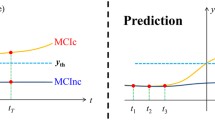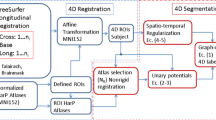Abstract
Alzheimer’s disease (AD) is a neurodegenerative disease and the most common form of dementia, affecting many millions around the world. Accurate prediction of AD is crucial for effective intervention. We develop a longitudinal data prediction framework based on functional data analysis to identify when an early prediction can reasonably be made. As the regional brain atrophy is related to AD progression, we fit our model to the longitudinal volumetric changes of five regions of interest (ROIs) quantified with MRIs: hippocampus (H), entorhinal cortex (EC), middle temporal cortex (MTC), fusiform gyrus (FG) and whole brain (WB). To evaluate the AD prediction based on each ROI and the combinations of some of them, we compare different choices by their accuracy, sensitivity, specificity and area under the curve (AUC) through training and testing procedures. The results show that these ROI volumes have prediction power as early as 3 years in advance. Among all the models, the overall sensitivity is around \(80\%\), specificity is above \(70\%\), accuracy is around \(75\%\) and AUC above \(80\%\). Among all the ROIs, EC is the best predictor (with the AUCs above 0.83 for 1-year and 2-year advanced prediction), followed by MTC and hippocampus. We also find that the combination of H + EC + MTC is the best combination (with AUCs of 0.86 for 1-year, 0.85 for 2-year, and 0.82 for 3-year advanced prediction). The key finding is that the AUC of 1-year prediction is not much different from that of 3-year prediction. In other words, we can use 3-year advanced prediction.





Similar content being viewed by others
References
Adaszewski, S., Dukart, J., Kherif, F., Frackowiak, R., Draganski, B., Alzheimer’s Disease Neuroimaging Initiative, et al.: How early can we predict Alzheimer’s disease using computational anatomy? Neurobiol. Aging 34(12), 2815–2826 (2013)
Aksu, Y., Miller, D.J., Kesidis, G., Bigler, D.C., Yang, Q.X.: An MRI-derived definition of MCI-to-AD conversion for long-term, automatic prognosis of MCI patients. PLoS ONE 6(10), e25074 (2011)
Arco, J.E., Ramírez, J., Górriz, J.M., Puntonet, C.G., Ruz, M.: Short-term prediction of MCI to AD conversion based on longitudinal MRI analysis and neuropsychological tests. In: Innovation in Medicine and Healthcare 2015, Springer, pp. 385–394 (2016)
Chawla, N.V., Bowyer, K.W., Hall, L.O., Kegelmeyer, W.P.: Smote: synthetic minority over-sampling technique. J. Artif. Intell. Res. 16, 321–357 (2002)
Cuingnet, R., Gerardin, E., Tessieras, J., Auzias, G., Lehéricy, S., Habert, M.O., Chupin, M., Benali, H., Colliot, O., Alzheimer’s Disease Neuroimaging Initiative, et al.: Automatic classification of patients with Alzheimer’s disease from structural MRI: a comparison of ten methods using the ADNI database. Neuroimage 56(2), 766–781 (2011)
Eskildsen, S.F., Coupé, P., García-Lorenzo, D., Fonov, V., Pruessner, J.C., Collins, D.L., Alzheimer’s Disease Neuroimaging Initiative, et al.: Prediction of Alzheimer’s disease in subjects with mild cognitive impairment from the ADNI cohort using patterns of cortical thinning. Neuroimage 65, 511–521 (2013)
Fennema-Notestine, C., Hagler, D.J., McEvoy, L.K., Fleisher, A.S., Wu, E.H., Karow, D.S., Dale, A.M.: Structural MRI biomarkers for preclinical and mild Alzheimer’s disease. Human Brain Mapp. 30(10), 3238–3253 (2009)
Hall, P., Maiti, T.: Choosing trajectory and data type when classifying functional data. Biometrika 99, 799–811 (2012)
Hartig, M., Truran-Sacrey, D., Raptentsetsang, S., Simonson, A., Mezher, A., Schuff, N., Weiner, M.: UCSF Freesurfer Methods. ADNI: Alzheimer’s Disease Neuroimaging Initiative, San Francisco (2014)
Jack, C.R., Knopman, D.S., Jagust, W.J., Shaw, L.M., Aisen, P.S., Weiner, M.W., Petersen, R.C., Trojanowski, J.Q.: Hypothetical model of dynamic biomarkers of the Alzheimer’s pathological cascade. Lancet Neurol. 9(1), 119–128 (2010)
Karow, D.S., McEvoy, L.K., Fennema-Notestine, C., Hagler Jr., D.J., Jennings, R.G., Brewer, J.B., Hoh, C.K., Dale, A.M.: Relative capability of MR imaging and FDG PET to depict changes associated with prodromal and early Alzheimer disease. Radiology 256(3), 932–942 (2010)
Lee, S.H., Bachman, A.H., Yu, D., Lim, J., Ardekani, B.A., Alzheimer’s Disease Neuroimaging Initiative, et al.: Predicting progression from mild cognitive impairment to Alzheimer’s disease using longitudinal callosal atrophy. Alzheimer’s & Dement. Diagn. Assess. Dis. Monit. 2, 68–74 (2016)
Leung, K.K., Barnes, J., Ridgway, G.R., Bartlett, J.W., Clarkson, M.J., Macdonald, K., Schuff, N., Fox, N.C., Ourselin, S., Alzheimer’s Disease Neuroimaging Initiative, et al.: Automated cross-sectional and longitudinal hippocampal volume measurement in mild cognitive impairment and Alzheimer’s disease. Neuroimage 51(4), 1345–1359 (2010)
Leung, K.K., Bartlett, J.W., Barnes, J., Manning, E.N., Ourselin, S., Fox, N.C., Alzheimer’s Disease Neuroimaging Initiative, et al.: Cerebral atrophy in mild cognitive impairment and Alzheimer disease rates and acceleration. Neurology 80(7), 648–654 (2013)
Li, Y., Wang, Y., Wu, G., Shi, F., Zhou, L., Lin, W., Shen, D., Alzheimer’s Disease Neuroimaging Initiative, et al.: Discriminant analysis of longitudinal cortical thickness changes in Alzheimer’s disease using dynamic and network features. Neurobiol. Aging 33(2), 427–e15 (2012)
McDonald, C., McEvoy, L., Gharapetian, L., Fennema-Notestine, C., Hagler, D., Holland, D., Koyama, A., Brewer, J., Dale, A., Alzheimer’s Disease Neuroimaging Initiative, et al.: Regional rates of neocortical atrophy from normal aging to early Alzheimer disease. Neurology 73(6), 457–465 (2009)
Misra, C., Fan, Y., Davatzikos, C.: Baseline and longitudinal patterns of brain atrophy in MCI patients, and their use in prediction of short-term conversion to ad: results from adni. Neuroimage 44(4), 1415–1422 (2009)
Müller, H.G.: Functional modelling and classification of longitudinal data. Scand. J. Stat. 32(2), 223–240 (2005)
Weiner, M.W., Veitch, D.P., Aisen, P.S., Beckett, L.A., Cairns, N.J., Green, R.C., Harvey, D., Jack, C.R., Jagust, W., Liu, E., et al.: The Alzheimer’s disease neuroimaging initiative: a review of papers published since its inception. Alzheimer’s Dement. 9(5), e111–e194 (2013)
Yao, F., Müller, H.G., Wang, J.L.: Functional data analysis for sparse longitudinal data. J. Am. Stat. Assoc. 100(470), 577–590 (2005)
Zhang, D., Shen, D., Alzheimer’s Disease Neuroimaging Initiative, et al.: Predicting future clinical changes of MCI patients using longitudinal and multimodal biomarkers. PloS ONE 7(3), e33182 (2012)
Zhang, L., Lim, C.Y., Maiti, T., Li, Y., Choi, J., Bozoki, A., Zhu, D.C., Key Laboratory of Applied Statistics of the Ministry of Education (KLAS), for the Alzheimer’s Disease Neuroimaging Initiative: Analysis of conversion of Alzheimer’s disease using a multi-state Markov model. Statistical methods in medical research p 0962280218786525 (2018)
Author information
Authors and Affiliations
Consortia
Corresponding author
Ethics declarations
Conflict of interest
All the authors declare that they have no conflict of interest.
Ethical approval
This article does not contain any studies with human participants or animals performed by any of the authors. Data used in preparation of this article were obtained from the Alzheimer’s Disease Neuroimaging Initiative (ADNI) database(adni.loni.usc.edu).
Additional information
Publisher's Note
Springer Nature remains neutral with regard to jurisdictional claims in published maps and institutional affiliations.
Data used in preparation of this article were obtained from the Alzheimer’s Disease Neuroimaging Initiative (ADNI) database (adni.loni.usc.edu). As such, the investigators within the ADNI contributed to the design and implementation of ADNI and/or provided data but did not participate in analysis or writing of this report. A complete listing of ADNI investigators can be found at http://adni.loni.usc.edu/wp-content/uploads/how_to_apply/ADNI_Acknowledgement_List.pdf.
Appendix
Appendix
The prediction performances for MRI plus model are listed in this section. While adding more relevant variables, MRI plus model performs better than the MRI base model, especially for 2 years and 3 years prediction. See Tables 11, 12, 13 and 14. For the statistical inference on the coefficients of logistic regression with inclusion and exclusion of gender, please see Tables 15 and 16.
Rights and permissions
About this article
Cite this article
Li, Y., Zhang, L., Bozoki, A. et al. Early prediction of Alzheimer’s disease using longitudinal volumetric MRI data from ADNI. Health Serv Outcomes Res Method 20, 13–39 (2020). https://doi.org/10.1007/s10742-019-00206-3
Received:
Revised:
Accepted:
Published:
Issue Date:
DOI: https://doi.org/10.1007/s10742-019-00206-3




